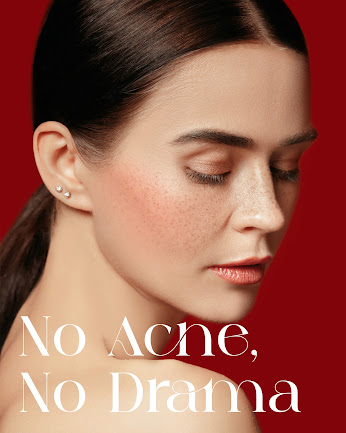Say Goodbye to Dark Spots: The Ultimate Guide to Treating Post-Inflammatory Hyperpigmentation
What Is Post-Inflammatory Hyperpigmentation (PIH)?
If you’ve ever noticed dark patches that appear after acne, a rash, or even a small scratch those stubborn marks are called post-inflammatory hyperpigmentation (PIH).
It happens when your skin produces excess melanin, the pigment that gives skin its color, in response to inflammation or injury. These spots are not scars; they are flat areas of discoloration that can last for weeks or even months.
PIH is especially common in medium to dark skin tones like most Indian skin because more melanin means a higher chance of pigmentation after inflammation.
The good news? With consistent care and the right ingredients, you can fade them effectively.
Why Does PIH Happen?
Whenever your skin gets irritated by acne, waxing, shaving, or even harsh scrubbing it triggers pigment-producing cells to release extra melanin. This leads to uneven patches or dark spots once the inflammation subsides.
Sun exposure and pollution can deepen the color of these spots, making them more noticeable and harder to fade.
To treat PIH effectively, your routine needs two focuses:
-
Calm the inflammation, and
-
Control melanin overproduction.
Prevention Is Key
Preventing PIH is always easier than treating it later. A few small changes can make a big difference:
-
Avoid picking or squeezing pimples. It pushes inflammation deeper into the skin and leaves darker spots.
-
Use gentle cleansers and exfoliants. Harsh products can damage your barrier and trigger pigmentation.
-
Wear sunscreen every day. Even when you’re indoors, UV rays can worsen dark spots.
Daily sun protection is non-negotiable it prevents new pigmentation and keeps existing marks from getting darker.
Ingredients That Help Fade PIH
Certain skincare ingredients are proven to fade dark spots, brighten uneven tone, and prevent new pigmentation. Here are the most effective ones:
🌿 Niacinamide (Vitamin B3)
-
Reduces the transfer of pigment to skin cells
-
Strengthens the skin barrier
-
Calms redness and irritation
Niacinamide is gentle, making it suitable for all skin types even sensitive ones.
🍊 Vitamin C
-
Inhibits melanin production
-
Brightens skin and adds glow
-
Protects from sun and pollution damage
Use it in the morning, before sunscreen, to boost radiance and even out your complexion.
💧 Azelaic Acid
-
Reduces acne and inflammation
-
Lightens dark spots and smooths texture
-
Suitable for acne-prone skin
This ingredient works well if your pigmentation is caused by breakouts.
🌸 Licorice Root Extract
-
Naturally brightens skin
-
Reduces redness and blotchiness
-
Helps prevent new pigmentation
A great option for those looking for gentle, botanical brighteners.
✨ Retinol (Vitamin A)
-
Speeds up cell turnover
-
Fades stubborn dark spots over time
-
Smooths fine lines and uneven texture
Start with a low concentration to let your skin adjust, and always follow with sunscreen the next morning.
Exfoliating Acids (AHAs like Glycolic or Lactic Acid)
-
Remove dead cells from the surface
-
Reveal brighter, smoother skin
-
Help other products absorb better
Use once or twice a week to avoid over-exfoliation, which can irritate skin and worsen pigmentation.
Your Simple Routine to Fade PIH
Consistency and patience matter most. Here’s a basic, easy-to-follow routine suitable for most Indian skin types:
Morning Routine
-
Cleanse gently to remove oil and buildup.
-
Apply a brightening serum with Vitamin C or Niacinamide.
-
Moisturize to strengthen your barrier.
-
Finish with a broad-spectrum sunscreen (SPF 30+).
Evening Routine
-
Cleanse away makeup, dirt, and sunscreen.
-
Use a targeted treatment serum with Niacinamide, Licorice, or Azelaic Acid.
-
Moisturize to support overnight repair.
-
Once or twice a week, use a gentle exfoliant to renew your skin.
When to Expect Results
Pigmentation doesn’t disappear overnight, but with consistent care:
-
Mild marks begin to fade in 6–8 weeks.
-
Deeper spots can take 3 months or more.
Be patient your skin tone will gradually become more even and radiant with regular use of the right products.
When to Seek Professional Help
If your pigmentation:
-
Doesn’t improve after 3–4 months of consistent care
-
Appears bluish-gray (indicating deeper pigment)
-
Worsens after using actives it’s time to consult a dermatologist. They can recommend mild chemical peels, laser treatments, or prescription creams to help you safely fade the spots.
Why Indian Skin Needs Extra Attention
Indian skin naturally has more melanin, making it more reactive to inflammation and UV rays. Combined with high humidity, pollution, and sun exposure, PIH becomes a very common concern.
The best approach is gentle brightening not harsh bleaching. Focus on maintaining a healthy barrier, controlling pigment, and protecting your skin from further damage.
Quick Recap
| Step | Focus | Key Ingredients |
|---|---|---|
| 1. Cleanse | Remove dirt, oil, impurities | Gentle surfactants |
| 2. Treat | Fade pigmentation | Niacinamide, Vitamin C, Azelaic Acid |
| 3. Moisturize | Strengthen barrier | Ceramides, Hyaluronic Acid |
| 4. Protect | Prevent new dark spots | Broad-spectrum SPF 30+ |
Final Thoughts
Post-inflammatory hyperpigmentation is completely normal and completely treatable.
With the right ingredients, consistent routine, and sun protection, you can fade those dark spots and restore your skin’s natural glow.
Progress may take time, but every small improvement brings you closer to clear, confident, even-toned skin. 🌸
FOR MORE INFORMATION VISIT
Glow Beyond Age: Expert Tips for Ageless Skin?
Understanding Combination Skin: How to Identify and Care for It?
Skin Purging: What It Is & How to Manage It?
Can Salicylic Acid Hydrate Your Skin? Let’s Find Out with Cathy Doll!
How to Safely Use Salicylic Acid, Retinol & Ceramides Together in Your Skincare
Brighten Up Naturally: Why Cathy Doll Whitamin-C Range Is a Must-Try




Comments
Post a Comment